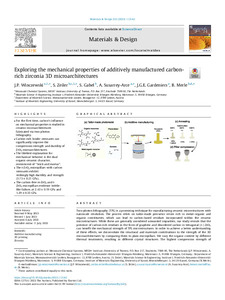Exploring the mechanical properties of additively manufactured carbon-rich zirconia 3D microarchitectures
| dc.date.accessioned | 2023-08-02T08:50:08Z | |
| dc.date.available | 2023-08-02T08:50:08Z | |
| dc.date.issued | 2023-07-11 | |
| dc.identifier | doi:10.17170/kobra-202308018552 | |
| dc.identifier.uri | http://hdl.handle.net/123456789/14964 | |
| dc.language.iso | eng | |
| dc.rights | Namensnennung 4.0 International | * |
| dc.rights.uri | http://creativecommons.org/licenses/by/4.0/ | * |
| dc.subject | additive manufacturing | eng |
| dc.subject | 3D printing | eng |
| dc.subject | zirconia | eng |
| dc.subject | micromechanics | eng |
| dc.subject | micropillar compression | eng |
| dc.subject.ddc | 600 | |
| dc.subject.ddc | 660 | |
| dc.title | Exploring the mechanical properties of additively manufactured carbon-rich zirconia 3D microarchitectures | eng |
| dc.type | Aufsatz | |
| dcterms.abstract | Two-photon lithography (TPL) is a promising technique for manufacturing ceramic microstructures with nanoscale resolution. The process relies on tailor-made precursor resins rich in metal–organic and organic constituents, which can lead to carbon-based residues incorporated within the ceramic microstructures. While these are generally considered unwanted impurities, our study reveals that the presence of carbon-rich residues in the form of graphitic and disordered carbon in tetragonal (t-) ZrO₂ can benefit the mechanical strength of TPL microstructures. In order to achieve a better understanding of these effects, we deconvolute the structural and materials contributions to the strength of the 3D microarchitectures by comparing them to plain micropillars. We vary the organic content by different thermal treatments, resulting in different crystal structures. The highest compression strength of 3.73 ± 0.21 GPa and ductility are reached for the t-ZrO₂ micropillars, which also contain the highest carbon content. This paradoxical finding opens up new perspectives and will foster the development of “brick and mortar”-like ceramic microarchitectures. | eng |
| dcterms.accessRights | open access | |
| dcterms.creator | Winczewski, Jędrzej Piotr | |
| dcterms.creator | Zeiler, Stefan | |
| dcterms.creator | Gabel, Stefan | |
| dcterms.creator | Susarrey Arce, Arturo | |
| dcterms.creator | Gardeniers, Han J. G. E. | |
| dcterms.creator | Merle, Benoit | |
| dc.relation.doi | doi:10.1016/j.matdes.2023.112142 | |
| dc.subject.swd | Rapid Prototyping <Fertigung> | ger |
| dc.subject.swd | 3D-Druck | ger |
| dc.subject.swd | Zirkoniumdioxid | ger |
| dc.subject.swd | Mikromechanik | ger |
| dc.subject.swd | Mechanische Eigenschaft | ger |
| dc.subject.swd | Lithografie | ger |
| dc.type.version | publishedVersion | |
| dcterms.source.identifier | eissn:0264-1275 | |
| dcterms.source.journal | Materials & Design | eng |
| dcterms.source.volume | Volume 232 | |
| kup.iskup | false | |
| dcterms.source.articlenumber | 112142 |
Dateien zu dieser Ressource
Das Dokument erscheint in:
-
Publikationen [14]


